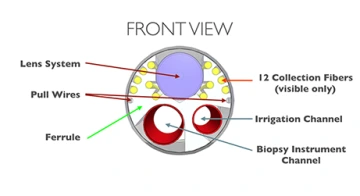Another Wavelength: David Vega

This month in Another Wavelength, we chat with second year Ph.D. candidate, David Vega.
Where are you from?
I am a US Citizen born in Guadalajara Mexico, so I am an American-Mexican (yes! American-Mexican).
What brought you to study optics?
I was first interested in optics when I joined Dr. Salik’s group at California State Polytechnic University Pomona (CALPOLY) for my first research project. I was in charge of developing an optical system for a cellphone to enable computational microscopy on the go. The potential medical applications that optics offer have been my main interest since then.
Who is your hero in science?
This is a very hard question. I have two that I can mention and have met in person.
Dr. Story Musgrave and Dr. Steven Chu.
Dr. Musgrave is the most educated astronaut with six academic degrees and many honorary doctorates. He was the astronaut in charge of repairing the Hubble Space Telescope and involved in classified missions. Believe it or not he is one of the two astronauts that has been in space more than six times. I met him at CALPOLY when he was visiting for college wide talk.
Dr. Steven Chu is an American Physicist who served as the 12th USA Secretary of Energy, a Nobel Prize in Physics winner, and director of many research facilities. His molecular biology research, while not very relevant to my research, inspired me to focus on optics applications for health. His career is outstanding and interesting to me. I met him while I was working at Stanford with the Gemini Planet Imager group, and I was impressed by his ability to manage everything he does.
Describe your research in 20 words or fewer.
I develop and build very challenging micro-endoscopes with multiple imaging systems such as OCT and MPM for early cancer detection.
Describe your research in 200 words or fewer.

I work in Dr. Barton’s lab. She is known for her novel endoscopes featuring challenging optical systems for cancer detection. She is currently focused in Ovarian cancer. I direct and collaborate with a small group of undergraduate students from mechanical engineering, biomedical engineering and optics engineering. Additionally, I collaborate with Dr. Rongguang Liang’s fabrication and testing facility, Optics Technology Inc. and Blue Ridge to manufacture the lenses and coatings that we need. We are in the phase of building an endoscope called the Salpingoscope for ovarian cancer detection. I designed the optical system to enable MPM and OCT and Visible imaging using a single optical system. With these modalities the physician using the endoscope can navigate the instrument to areas of interest using the Visible navigation channel. Once the area of interest has been identified, the endoscope can be used to acquire high resolution microscopy using the MPM channel and morphological imaging using OCT of the same area. With this information of the area of interest it can be diagnosed for cancer with high specificity.
Name three neat facts about you.
- Helping people is one of my passions! If I can, I help! Right now, I am doing a fundraiser to help students in economic distress. Donate today!!!
- I used to be an athlete (believe it or not), a musician, an astronomer, a physics teacher and a small business owner before getting to graduate school.
- My wife and I solved the two body problem for graduate school early on. We both got accepted to University of Arizona the same year. She is in the Mathematics PhD with minor in Education and I am in the Optics PhD with minor in Biomedical Engineering.
Research Caption:
The diagram depicts the front view of the endoscope that is currently being built. The 12 fibers are collectors of light to reconstruct images. It features two working channels for irrigation and biopsy collection and the multi purpose optical system.
